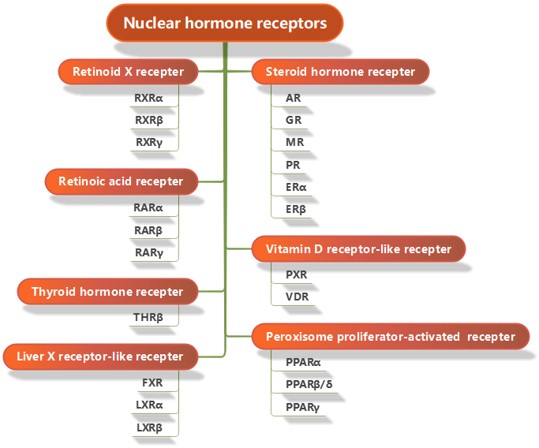Nuclear Hormone Receptors (NHRs) are a class of proteins found within cells that are responsible for sensing steroid and thyroid hormones, as well as certain other molecules. These receptors play a crucial role in regulating gene expression and maintaining homeostasis in the body. Given their central role in various physiological processes, NHRs have become vital targets in drug discovery, particularly for treatments of cancer, metabolic disorders, and endocrine diseases.
The competitive binding assay is a primary method used to evaluate interactions between potential drug candidates and NHRs. This assay employs a fluorescently labeled ligand, known as a Fluormone tracer, which binds to the receptor.
Key Points:
▪ Fluormone Tracer: This fluorescent ligand binds to NHRs and emits a measurable signal.
▪ Competition: When a drug candidate is introduced, it competes with the Fluormone tracer for the receptor's binding sites.
▪ Polarization Change: The binding event causes a change in the polarization of the emitted fluorescence, which can be quantified to determine the binding affinity of the drug candidate.
The coactivator recruitment assay is an advanced technique used to study the interactions between NHRs and coactivators, essential for transcriptional activation, using Homogeneous Time-Resolved Fluorescence (HTRF).
Key Points:
▪ HTRF Principle: HTRF combines fluorescence resonance energy transfer (FRET) with time-resolved measurement to reduce background fluorescence and improve assay sensitivity.
▪ Binding Interaction: When the NHR binds to the FI-PEPTIDE, the donor and acceptor molecules come into close proximity, allowing energy transfer from the terbium donor to the fluorescent acceptor.
▪ Fluorescence Emission: The energy transfer results in a specific fluorescence emission from the acceptor molecule, which can be measured. The intensity of this fluorescence indicates the extent of coactivator recruitment.
The cell-based reporter assay is a powerful tool used to evaluate the activity of NHRs within a cellular context. This assay provides a more physiologically relevant environment, allowing researchers to observe the effects of potential drug candidates on NHR activity within living cells.

Key Points:
▪ Reporter Genes: Commonly used reporters include luciferase. These genes are placed downstream of Hormone Response Elements (HREs) or UAS-GAL4 RE (Upstream Activating Sequence - GAL4 Response Element), providing a measurable signal upon activation by NHRs.
▪ Provides insights into how potential drug candidates affect NHR activity in a cellular environment, closely mimicking in vivo conditions.
▪ The cell-based reporter assay, incorporating components such as Ligand-Binding Domain (LBD), DNA-Binding Domain (DBD), HREs, and UAS-GAL4 RE, offers a robust and physiologically relevant method to study NHR activity in living cells. By measuring changes in reporter gene expression, this assay provides valuable insights into the activation or inhibition of NHRs, aiding in the discovery of novel therapeutics targeting these crucial receptors.
We value your inquiries and are here to provide you with tailored solutions for your drug discovery and development needs. Whether you have questions, require more information, or are interested in discussing potential collaborations, our team of experts is just a message away.
Feel free to reach out to us.